The COVID-19 pandemic has exacerbated several challenges related to securing economic and physical safety in many of Houston communities. Although the stay-at-home order in mid-March has helped control the spread of the virus (view COVID-19 cases here), it has brought the local economy to a halt. Initial jobless claims, e.g. claims for unemployment benefits filed by unemployed individuals with state unemployment agencies, have reached levels never before seen — both in Texas and across the nation.
Meanwhile, small businesses have been struggling to survive. Through the Paycheck Protection Program (PPP), the Small Business Administration (SBA) was able to provide special loans to help businesses keep their employees on the payroll during the COVID-19 crisis. In Texas, more than 365,000 loans up to $150,000 each have been given out to qualifying small businesses through participating lenders. (Click here to view the number of PPP loans and the amount approved by ZIP code.) It was a lifeline for many small businesses in the region. However, the SBA closed applications on Aug. 8, 2020, and the economy hasn’t recovered from the pandemic yet.
In early May, many businesses in Texas were able to reopen in three phases. However, data suggests that nearly a quarter of all small businesses remain closed nationwide. Small businesses in the leisure and hospitality sectors have been hit the hardest. In Houston, about one-third of small businesses remain closed, and 58% of small businesses in the leisure and hospitality sectors report no transaction data.
Job loss and impacted industries
According to a recent analysis of unemployment insurance claims data by the Gulf Coast Workforce Board, for the weeks ending March 7 to Oct. 10, 2020, almost 1.2 million individuals have filed for unemployment across the 13-county Gulf Coast region.1
Over the 7-month period, there were 326,259 claims for unemployment insurance among claimants between the ages of 16 and 29. This represented 27% of total unique claimants. Among those younger claimants, 15% were ages 16 to 19; 44% were 20 to 24; and 41% were 25 to 29 years old.
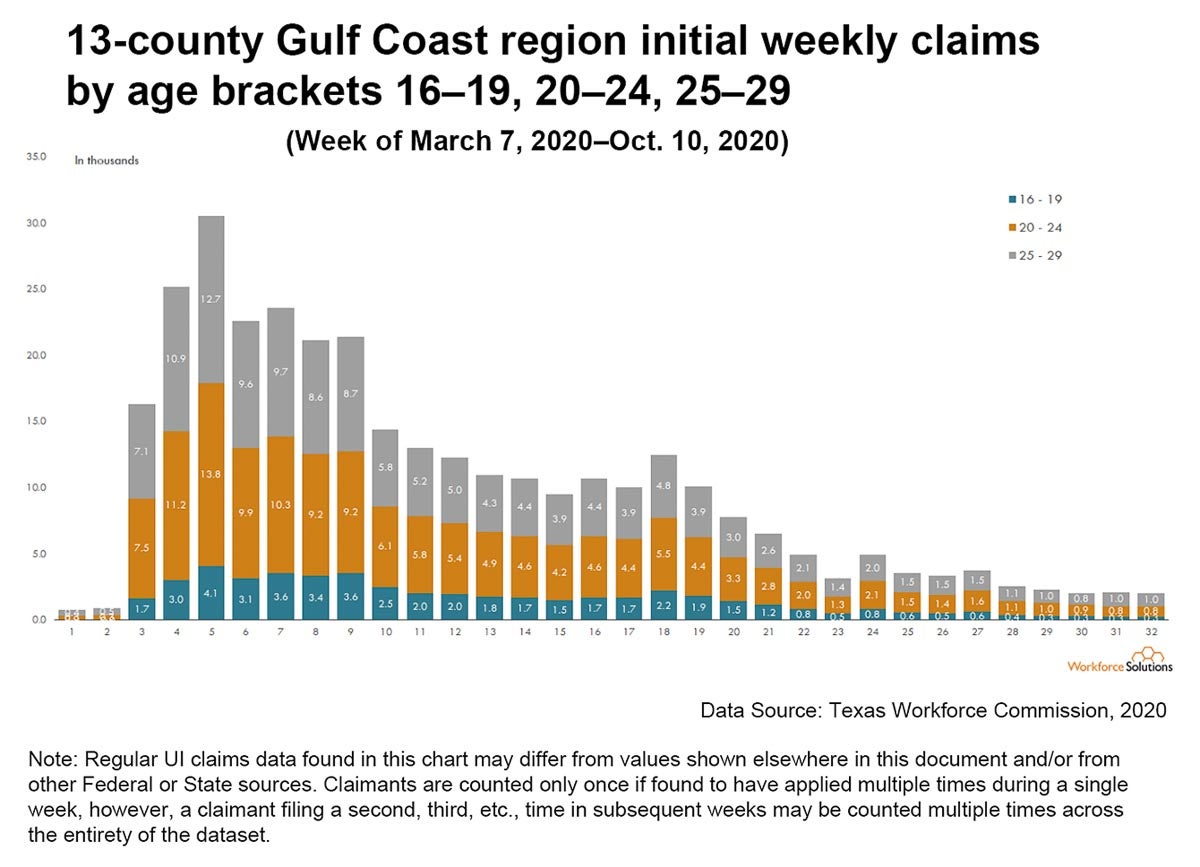
Since the onset of the pandemic, job losses in the Houston region have been concentrated in industries such as accommodation, food services and retail trade. The chart below shows the share of unemployment insurance claims by sector for 16- to 29-year-old workers. Virtually 40% of those young claimants worked in the accommodation, food services and retail trade sectors before the pandemic. More than 8% of them worked for arts, entertainment or recreation businesses. Another 7% were employed in administrative and waste management services; however, because of the disparate group of industries found in this sector, including temporary staffing firms, the exact nature of the jobs held by those in the 16- to 29-year-old age group is unclear.
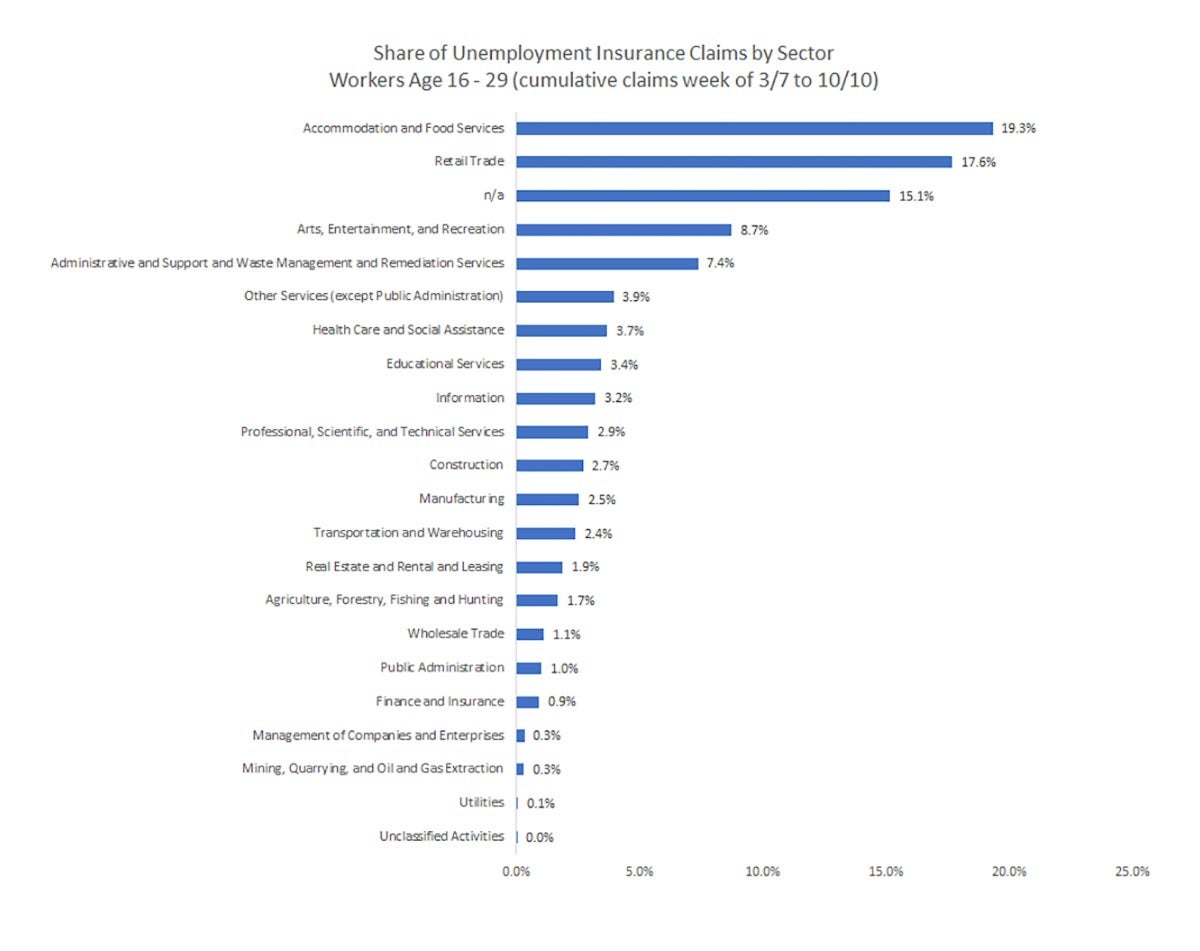
An analysis of the Longitudinal Employer-Household Dynamics (LEHD) data also shows that in Harris County, 35% of workers ages 16 to 29 worked in the accommodation, food services, and retail trade sector before the pandemic, and another 10% worked in the health care and social assistance sector, which has been impacted to a lesser degree.
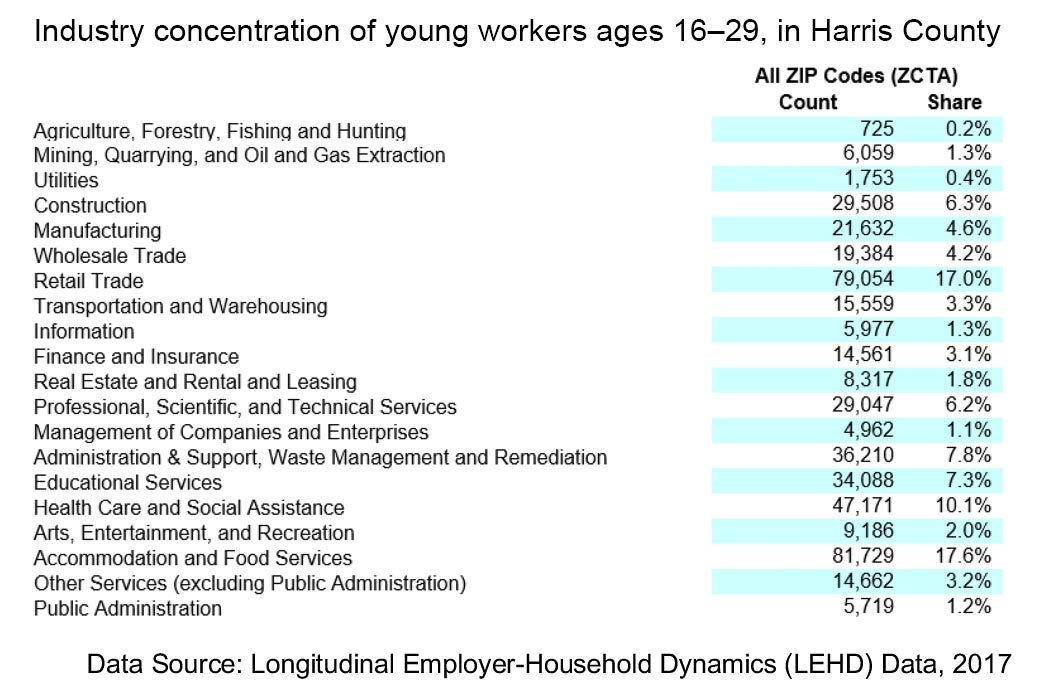
Additionally, the majority of jobs impacted in those industries are low-paying jobs. The chart below illustrates the share of unemployment insurance claims by occupation for those young claimants. Jobs in the “food preparation and serving related” sector, which represent one-fifth of unemployed workers in the 16- to 29-year-old age group, were paid an average of $10.34 an hour, according to the 2019 Occupational Employment Statistics survey. While this is roughly $3 an hour more than the federal minimum wage of $7.25 an hour, it is barely half of the Houston region’s median hourly wage of $19.44. Jobs in sales and personal care, which combined represent another 25% of the unemployment claims in this age group, paid slightly higher hourly wages of $14.09 and $11.36, respectively.

Impacted communities
As a first step in determining where workforce development needs are greatest among young workers, we mapped LEHD data to identify neighborhoods in Harris County where relatively high concentrations of low-paying workers between the ages of 16 and 29 lived before the pandemic. Overall, these individuals tended to reside in ZIP codes bordering county lines, with slightly higher concentrations in neighborhoods in western Harris County.
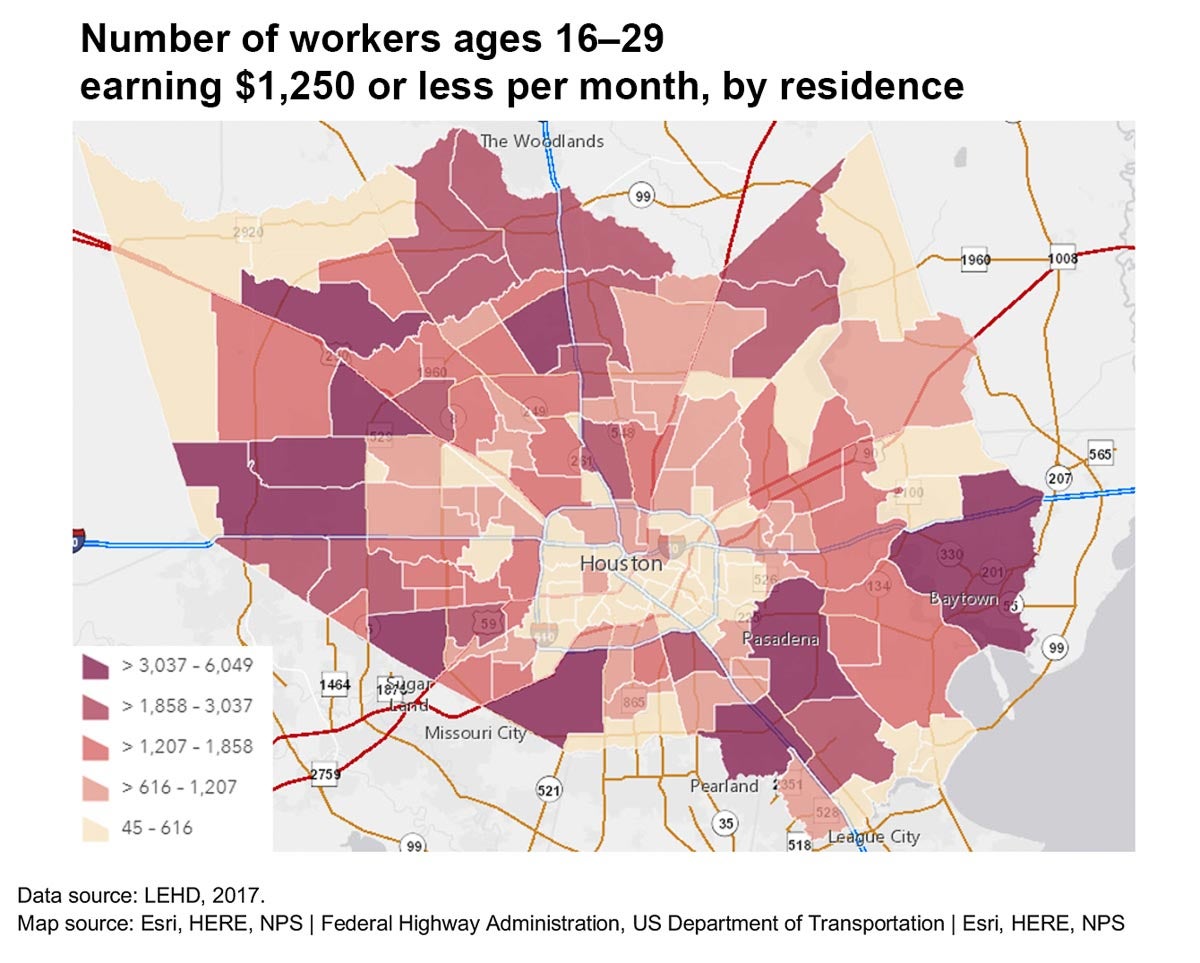
As a comparison, we mapped the unemployment insurance claims by ZIP code among individuals ages 16 to 29 across the entire region. This revealed that seven of the top 10 ZIP codes were concentrated in the western part of Harris County and eastern Fort Bend County between Beltway 8 and the Grand Parkway. Other areas with high concentrations of young unemployed workers included the Cypress Station, Spring and Baytown areas. Overall, we found significant overlap between the two maps, which suggests that job losses related to COVID-19 amplified existing inequalities, particularly among young low-income workers who were most likely employed in industries that experienced the largest disruptions from the pandemic, as noted above.
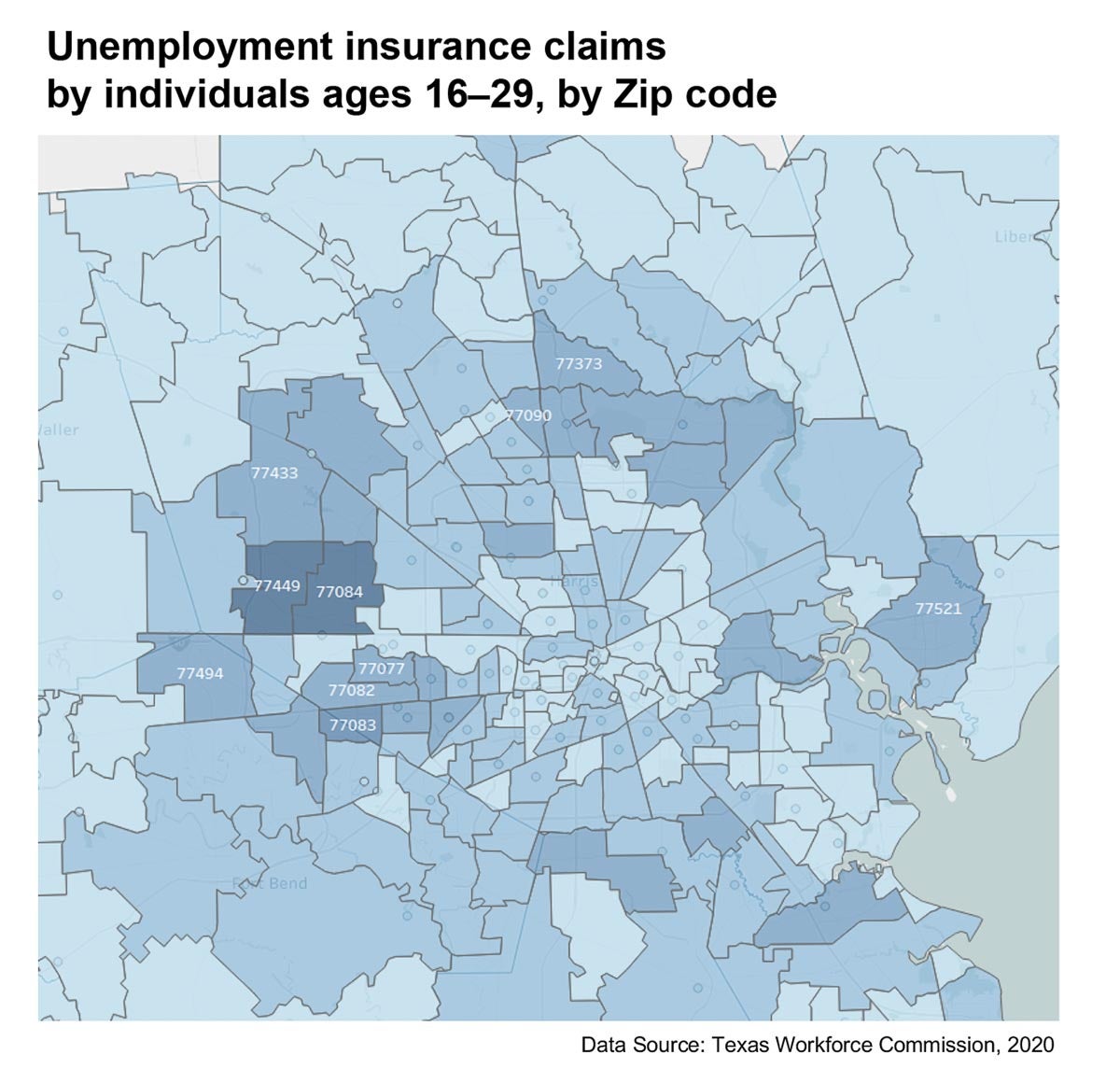
Opportunity Youth and the potential impacts of COVID-19
A subset of the population related to the young people highlighted thus far are individuals ages 16 to 24 who are neither working, looking for work nor in school. These individuals are often referred to as Opportunity Youth or Disconnected Youth. According to a recent study conducted by the Federal Reserve Bank of Dallas, 13.4% of 16- to 24-year-olds living in Harris County meet this definition. The proportion of Opportunity Youth was highest among Black residents at 16%, compared to 14% of Hispanics and 11% of whites in the age group; however, these trends predate COVID-19. As a result, there is concern that the pandemic’s disruptive effects may further disincentivize re-engagement with education and employment among this population given that the long-term resilience of both institutions remains uncertain, despite some signs of recovery.
The arrival of COVID-19 in March of 2020 disrupted nearly all facets of society, altering consumer habits and travel patterns, in turn leading to diminished demand for goods and services and in many cases, fewer workers. As highlighted in this article, younger workers that were concentrated in relatively low-wage service sector industries and occupations have borne the brunt of the pandemic’s economic impacts.
This has the potential to exacerbate existing inequalities by interrupting the skill acquisition that occurs while working along with the long-term accumulation of earnings. Opportunity Youth, already possessing marginal attachment to education and employment, now face additional barriers due to the pandemic.
Fortunately, there are organizations across the region working to maximize the economic potential of young adults by connecting them to services that can help overcome existing structural challenges, as well as recent ones brought on by COVID-19. One example is Mayor Sylvester Turner’s Health Equity Response Task Force’s COVID-19 Community Health Education Fellows (CHEF) program. It combines a 10-week training program that provides a certification in community health work and contract tracing at a local community college with a paid externship where the fellows work with the most vulnerable communities to help develop a targeted public health education campaign.
Another example can be found in the regular and special activities of the Gulf Coast Workforce Board and Workforce Solutions, which together form the public workforce system for the 13-county region, which includes Greater Houston. They provide resources for young adults such as job search seminars, career information (including links to education and training requirements) and access to short-term summer employment opportunities. The latter program was suspended for 2020 because of the pandemic; however, virtual job fairs connected employers to young workers. Ultimately, while many young workers continue to face challenges in light of COVID-19’s effects on the job market, supportive services, coupled with the gradual recovery of the economy, will continue to aid these individuals in their return to full participation in the job market.
Notes: Claimants are counted only once if found to have applied multiple times during a single week, however, a claimant that filed a second, third, etc. time in subsequent weeks may be counted multiple times across the entirety of the dataset. The presence of a claimant does not automatically signify that they met eligibility requirements for receiving UI, only that they submitted an application during the week specified.
Parker Harvey is a regional economist at Gulf Coast Workforce Solutions.

